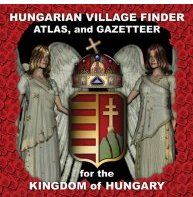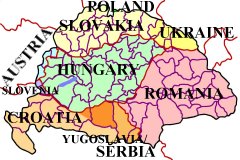
Genealogy Guide
for
Locating ancestral cities, towns,
places, settlements, villages, and
place names in the
Kingdom of Hungary

| HUNGARIAN VILLAGE FINDER, ATLAS, and GAZETTEER for the KINGDOM of HUNGARY |
 |
-How to Find- Genealogy Guide for Locating ancestral cities, towns, places, settlements, villages, and place names in the Kingdom of Hungary |
 |
| --If your genealogy
research has you trying to find or
identify a city, community, settlement, town, place, or village name in
the
former Kingdom of Hungary, Austria-Hungary, or Austro Hungarian Empire
including those now located in Austria, Croatia, Hungary, Poland,
Romania,
Serbia, Slovakia, Slovenia, Ukraine, and the former Yugoslavia... --If your family history inlcudes Austrian, Croatian, Donauschwaben, Galician, German, Hungarian, Magyar, Polish, Romanian, Rusyn, Ruthenian, Serbian, Slovak, Slovakian, Slovenian, Ukrainian, or Yugoslavian ancestry, heritage, or roots... --If you are looking in the areas and/or regions commonly known or referred to as Banat, Batschka, Burgenland, Erdeley, Kartapalja, Ruthenia, Transylvania, Vojvodina, or Zakarpattia... the following guide will help you understand and hopefully overcome some of the problems and pitfalls with trying to learn the town of origin, as well as offering a list of documents and websites where you can look for the place of birth of your ancestor.
--Handwritten script—this one can present a real problem as all too often the names of our ancestors as well as the places they came from were written down with little more than a scrawl across the line. Deciphering or trying to interpret that scrawl can require some real detective work, however, by working back and forth with the Hungarian Village Finder’s indexes and the source, the place name can usually be determined. (A few hints from the HVF—determine the first letter of the placename! Beware of letter look-a-likes such as the letters “B, H, K, and R.” Look at the handwriting throughout the source you are using and compare, compare, compare. Once you have a first letter, try to determine a group of letters. Then use the built in “FIND” tool to find place names with that particular combination of letters). --Places
/ place names that no longer
exist. Obviously, this can complicate
your search especially if you are trying to use modern day maps and/or
atlases. Getting Started-- --Visit the HVF "Hungarian / Hungary Genealogy Charts and Forms" website to download free printable Family Group Sheets and Pedigree Charts created to help you learn the identity of ancestral placenmaes. --Follow the “golden rule of genealogy” by beginning with your self and working backwards. Make a list of family members including their birthdates and birth places. Do not assume anything and try to document everything. This is the information that will lead you to the location of the records which in turn, will hopefully lead you to your ancestral village(s). --Make a timeline in 10 year increments and enter the name, birthdate, and birthplace of your parents, aunts, uncles, grandparents, etc.. This will visually show you who and where each person was living during a given time period, which once again, will lead you to the location and availability of certain records created during that time frame. --Go
on the internet and find a simple
but good pronunciation
guide for Hungarian and one for whatever was the spoken language of
your
ancestors. Print these out.
You do not need to study them, but
familiarize yourself with a few of the phonetics so that you are
consciously
aware of differences and similarities in spelling. Family Search Frequently asked questions about the Family History Library Online Family History Catalog Find a LDS Family History Center near you --Viist the National Archives or NARA website for Genealogists and Family Historians to learn all about the types and availability of records kept by the United States Government. --Call or visit your local library. Find out what kind of genealogy records they have. Ask if and what kind of microfilms they have and learn to use a microfilm and/or microfiche reader. Many libraries have some of the U.S. Census records and if they do not hold them, can order them through inter-library loans. Also, be sure to ask if they have a subscription to Ancestry.com or HeritageQuest Online as both of these offer access to complete sets of Federal Census records from 1790-1930. Where to look for a place name-- --Now, call or visit a few of your relatives and ask if they know where your grandparents or great-grandparents came from. If they say Budapest, Bratislava, Zagreb or any other big place, understand that most likely they did not come from these large cities, but said so to simplify having to try and explain where their very small village was located. Everything else, write it down!!! Ask them to repeat it and to say it slowly. No matter how you hear it, write it down again and again if necessary. Ask them how they might spell it and write it down. If they try to pronounce the place several different ways, write each and everyone of those down. Weeks, months, or maybe even years from now, you’ll either be very happy you wrote and saved this information, or you’ll be kicking yourself because you did not. Save the heartache, write it ALL down now.If you are really lucky, perhaps you will learn the name of your village with a phone call or two and using the HVF, be able to find it, along with a wealth of information about it, in a few moments time. If, on the otherhand, you are like most of us, you will have to do some searching.
Stephen Morse's "Searching the New York (Ellis Island) Database in One Step" "Link to Your Roots" Hamburg emigration lists Ancestry.com U.S. Immigration Collection (requires a paid subscription but allows the user to search and view manifests from their home. No charge to take a look at the ports and records offered). Hint--Check with your local library to see if they have a subscription to this site. They may offer their patrons free access to the database. Microfilms of immigration records are available through NARA (National Archives) and the LDS Family History Library and their local Centers. For more information see Immigration Arrival Records
See Naturalization Records from the U.S. Citizenship and Immigration Services for more information and Online Family History Catalog to see what records they have (check by state name). Note--Check county libraries as many of these now have local Naturalization records in their collections.
Social Security (death records) can
provide
Social Security search
via LDS Family Search --World War I Draft Cards can provide
During World War I there were three
registrations. The first, on June 5, 1917, was for all men between the
ages of 21 and 31. The second, on June 5, 1918, registered those who
attained age 21 after June 5, 1917. (A supplemental registration was
held on August 24, 1918, for those becoming 21 years old after June 5,
1918. This was included in the second registration.) The third
registration was held on September 12, 1918, for men age 18 through 45. Original records are kept at the
National Archives branch in Atlanta, Georgia --Church records
Upon their arrival to their new
hometowns, many of our ancestors sought out local ethnic
churches. For the most part, these churches kept very detailed
records about their parisoners. Marriage records usually provide
the best information but baptism records of offspring may offer the
birthplace of the parents, as well. Try to locate the church
where your ancestors would have gone for services and request the
information. Be sure to ask for original records not just
certificates and let them know you are trying to find the town your
ancestors came from. Consider making a small donation for their
time. Note--the LDS (Latter
Day Saints or Mormons) Family History Library has
acquired many local church records including some Catholic
records. Check the Online
Family History Catalog by entering the name of the state, county,
and town to see what, if any of these records are available.
--Vital
Records Also try county registrars. This is usually the place where you will find the application for a license. A note about DEATH records and OBITUARIES-- Obviously, whatever information being provided about the deceased is coming from someone other than the deceased, which automatically makes it subject to error. Then, considering that most of this information supplied is coming from a family member, who under the circumstances is probably quite distressed, the birthplace is simply put down as the country of origin. Rarely, will you find a village or town name recorded. --United States Federal Census Records Taken every ten years, most likely none of these records will provide you with a place name of origin other than perhaps Hungary, Austria, Germany, etc.. They can, however, be used to place your ancestors in certain places at certain times which can then lead you to other records which may have the information you are looking for. Pay close attention to the birthplaces listed for the children as families may have moved from place to place during the 10 years in between censuses. Look back and ahead a few pages and note other people of the same ethnic background who lived close by. If all else fails in trying to locate ancestral villages, descendants of these neighbors may be able to help you. And you never know, you may find a relative living the next street over that you never knew you had! Most county libraries now have the census records for their particular county and many have them for the entire state. Call and ask what is available. Subscription sites like Ancestry.com or HeritageQuest Online have the census collections. You can use these sites to view and print copies of the actual documents from your home computer. The LDS (Latter Day Saints or Mormons) Family History Library also has the full collection of census records available on microfilm. Most of our ancestors were uneducated and illiterate. They could not read, write, or spell, nor could they speak English. Spoken with heavy foreign accents, whatever place names were given and entered into records and documents, were most likely done phonetically. The Hungarian Village Finder, Atlas, and Gazetteer for the Kingdom of Hungary (HVF) can help you to decipher those places by allowing you to browse through several indexes. Upon arrival in the United States, most immigrants went to live with or nearby family or friends. If you have exhausted all the sources listed above, you may want to try locating other families from the same area that your family lived. Quite often, their ancestors were from the same birth village as your's were. This is where the U.S. Federal Census and the State Census records can be very useful. Finally, whatever you do, do not give up. You know your ancestors had to come from somewhere, it's just a matter of finding the name of that place.
|
|
Hungarian Village Finder, Atlas, and Gazetteer for the Kingdom of Hungary (website) and Hungarian Village Finder, Atlas, and Gazetteer for the Kingdom of Hungary (software) Copyright 2001-2005 All rights reserved. |